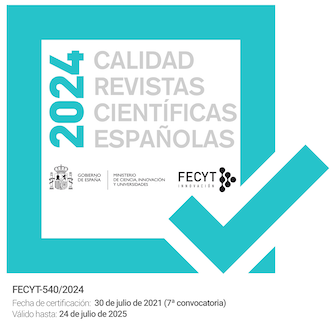The Female Characters in Strawberry and Chocolate: Senel Paz Played by Gutiérrez Alea
DOI:
https://doi.org/10.30827/rl.vi29.24246Keywords:
Cuban Literature, Cuban Cinema, Tomás Gutiérrez Alea, Senel Paz, Strawberry and ChocolateAbstract
The criticism of the story “The wolf, the forest and the new man” and the film Strawberry and chocolate has emphasized the confrontation between the “new man” and the marginalized homosexual, but there has been no attention to a nuance that gives depth and extension to the film above the text: the role and significance of the two leading women, Vivian and Nancy. The first appears briefly in Senel Paz's short story, while Nancy is a creation of the screenwriters, symbolizing the generation born before the revolutionary triumph, while Vivian, younger and with a larger role in the film, embodies the generation of those who they were born within the revolutionary process. The relevance of these two figures breaks the tendency to binary new man / homosexual with which the story is presented, and provides keys to interpret the evolution of Cuban society in the second half of the 20th century.
Downloads
References
Álvarez-Tabío, Emma. Invención de La Habana. Barcelona, Casiopea, 2000.
Alvear, Marta. “An lnterview with Humberto Solás: Every Point of Arrival Is a Point of Departure”. JumpCut, nº 19, 1977, pp. 27-33.
Bobes, Velia Cecilia. “Las mujeres cubanas ante el período es-pecial: ajustes y cambios”. Debate Feminista, nº 23, 2001, pp. 67-96.
Cabrera Arús, María A. y Suquet, Mirta. “La moda en la litera-tura cubana (1960-1979)”. Cuban Studies, nº 47, 2019, pp. 195-221.
Carpentier, Alejo. La ciudad de las columnas. La Habana, Le-tras Cubanas, 1982.
Carpentier, Alejo. El amor a la ciudad. Madrid, Alfaguara, 1996.
Carrión, Miguel de. Las impuras. Madrid, Cátedra, 2011, Ángel Esteban y Yannelys Aparicio (eds.).
Chanan, Michael. “Estamos perdiendo todos los valores. Tomas Gutiérrez Alea entrevistado por Michael Chanan”. Encuentro de la Cultura Cubana, nº 1, 1996, pp. 71-76.
Cusato, Domenico Antonio. “Fresa y chocolate de Senel Paz: régimen y homosexualidad”. INTI, nº 59/60, 2004, pp. 123-132.
Dzhyoyeva, Mariya. “Cons(des)trucción del espacio urbano y el discurso identitario en la obra de Antonio José Ponte”. Revista Canadiense de Estudios Hispánicos, nº 40, 2, 2016, pp. 315-332.
Esteban, Ángel. El hombre que amaba los sueños: Leonardo Padura entre Cuba y España. Bruselas, Peter Lang, 2018.
Esteso, Santiago. “Los excluidos de la masculinidad. Espacio nacional y regulaciones sexuales en Cuba”. Dossieres feminis-tes, nº 6, 2002, pp. 73-96.
Évora, José Antonio. Tomás Gutiérrez Alea. Madrid, Cátedra, 1996.
Foucault, Michel. Estética, ética y hermenéutica. Obras esen-ciales III. Barcelona, Paidós, 1999.
García, Christina. “Baroque Revolutionaries, Communist Fags, and Risky Friendships: Reading the Politics of Friendship in Fresa y chocolate”. Cuban Studies, nº 47, 2019, pp. 222-244.
Guevara, Ernesto. El hombre nuevo. México, UNAM, 1978.
Gutiérrez Alea, Tomás. “Fresa y chocolate y una aclaración”. El Nuevo Herald, Abril 27, 1994, p. 14.
Kirkpatrick, Susan. “The Ideology of Costumbrismo”. Ideolo-gies and Literature, vol. 2, nº 7, 1978, pp. 28-44.
Lahr-Vivaz, Elena. “¿Qué cosa eres?: Reading refractive Melo-drama in Humberto Solás’ Cecilia”. Chasqui, vol. 46, nº 1, 2017, pp. 153-166.
Mejía, Glenda. 2009. “Mujeres en dos épocas del cine cubano”. Razón y palabra, nº 66, 14, 2009, s/p.
Padura, Leonardo. Máscaras. Madrid, Cátedra, 2022, Ángel Esteban y Yannelys Aparicio (eds.).
Paz, Senel. Fresa y chocolate. Tafalla, Txalaparta, 1997.
Phaf, Ineke. Novelando La Habana. Madrid, Orígenes, 1990.
Redruello, Laura. “La mujer en el espacio fílmico de Tomás Gu-tiérrez Alea”. La palabra y el hombre, nº 132, 2004, pp. 47-61.
Ricoeur, Paul. Tiempo y narración I. Configuración del tiempo en el relato histórico. Madrid, Siglo XXI, 1995.
Rodríguez, Ileana. “Recapitulando. Volver a Ernesto Che Gue-vara-El Che”. Mitologías hoy, nº 24, 2021, pp. 33-43.
Sagot, Montserrat (coord.). Feminismos, pensamiento crítico y propuestas alternativas en América Latina. Buenos Aires, CIEM-CLACSO, 2017.
Santana, Astrid. Literatura y cine. Lecturas cruzadas sobre Memorias del subdesarrollo. Santiago de Compostela, Univer-sidad de Santiago, 2010.
Sanz Abad, Pedro. “Presencia de Virgilio en la Divina Come-dia”. Boletín de la Institución Fernán González, 4/9, nº 175, 1970, pp. 266-280.
Schroeder Rodríguez, Paul A. “Las múltiples modernidades del cine latinoamericano”. Hispanófila, nº 177, 2016, pp. 75-87.
Sommer, Doris. Ficciones fundacionales. Las novelas naciona-les de América Latina. México, Fondo de Cultura Económica, 2004.
Toledo, Teresa. “Conversando con Senel Paz”. Viridiana. Revis-ta trimestral sobre el guion cinematográfico, nº 7, 1994, pp. 141-163.
Vicent, Mauricio. “O fresa o chocolate”. El País, 12 de diciem-bre de 2018. https://elpais.com/elpais/2018/12/11/mas_se_perdio_en_la_habana/1544565783_028662.html
Viera, Katia. “La Habana: efecto buitre y escritura posnacio-nal”. Hispamérica, nº 141, 2018, pp. 109-114.
Wood, David. “Tomás Gutiérrez Alea and the Art of Revolu-tionary Cinema”. Bulletin of Latin American Research, vol. 28, nº 4, 2009, pp. 512-526.
Downloads
Published
How to Cite
Issue
Section
License
Revista Letral is an open access journal under a Creative Commons Atribución-NoComercial 4.0 license.
The works published in this journal may be reused, distributed and publicly presented for non-commercial purposes, provided that: cite the authorship and the original source of the publication (journal, publisher and URL of the work).
We strongly recommended you to share our published articles in social and scientific networks, institutional and public repositories, personal or institutional websites, blogs, Google Scholar, ORCID, ResearchID, ScopusID, etc.
The journal allow the author(s) to hold the copyright and to retain publishing rights without restrictions.
We are completely free, both for readers and authors.














